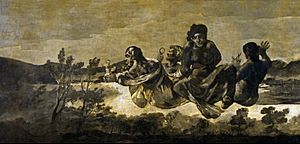Atropos (Goya) facts for kids
Quick facts for kids Atropos / The Fates |
|
|---|---|
| Spanish: Átropos / Las Parcas | |
 |
|
| Artist | Francisco Goya |
| Year | 1819–1823 |
| Medium | Oil mural transferred to canvas |
| Dimensions | 123 cm × 266 cm (48 in × 105 in) |
| Location | Museo del Prado, Madrid |
Atropos, also known as The Fates, is a famous painting by the Spanish artist Francisco de Goya. He created this artwork between 1819 and 1823. It is one of 14 paintings known as the Black Paintings.
Goya painted these artworks directly onto the walls inside his house. His home was called the Quinta del Sordo, which means "House of the Deaf Man." Goya was about 75 years old when he painted them.
Years later, in 1873–74, these paintings were carefully moved from the walls. They were transferred onto canvas so they could be preserved. This work was done by Salvador Martínez Cubells, a curator at the Museo del Prado. In 1881, the owner, Baron Emile d'Erlanger, gave the paintings to the Spanish government. Today, you can see Atropos and the other Black Paintings at the Prado Museum in Madrid, Spain.
What is Atropos About?
This painting shows a story from ancient Greek myths. It features the goddesses of destiny, also known as the Moirai or Fates. These goddesses decide what happens in people's lives. Writers like Homer and Virgil wrote about them.
Who are The Fates?
The painting shows three main female figures floating in the air. They are:
- Atropos: She is the goddess of death. She holds a pair of scissors, ready to cut the "thread of life." This means she decides when someone's life ends.
- Clotho: She usually spins the thread of life. In Goya's painting, she holds what looks like a doll or a newborn baby. This might represent new life or beginnings.
- Lachesis: She measures the length of the life thread. In the painting, she looks through a lens or into a mirror. This could symbolize time passing or looking into the future.
The Fourth Figure
There is also a fourth figure in the painting, in the front. This figure appears to be a man. His hands are tied behind his back, as if he is a prisoner. Many people think this means the Fates are deciding his future, and he cannot do anything to change it. Some believe this figure might be Prometheus. In Greek myth, Prometheus was punished by the gods and tied to a mountain.
Colors and Style
Like Goya's other Black Paintings, Atropos uses very few colors. It mainly features dark shades like browns, blacks, and ochres (yellowish-browns). This limited color palette makes the painting feel dark and dreamlike. It creates a mysterious mood that fits the mythical subject.
Goya's Black Paintings are known for their unusual and sometimes strange style. They are seen as early examples of modern art because they show feelings and ideas in a new way.
See also
 In Spanish: Átropos o Las Parcas para niños
In Spanish: Átropos o Las Parcas para niños
- List of works by Francisco Goya

